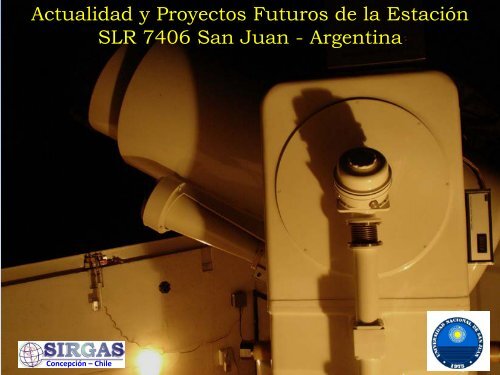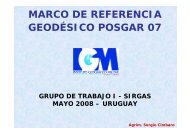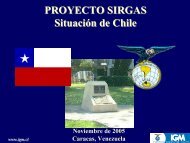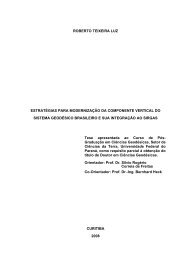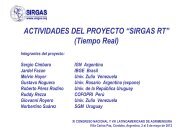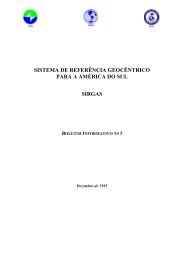actualidad y proyectos futuros de la estación slr 7406 san ... - SIRGAS
actualidad y proyectos futuros de la estación slr 7406 san ... - SIRGAS
actualidad y proyectos futuros de la estación slr 7406 san ... - SIRGAS
You also want an ePaper? Increase the reach of your titles
YUMPU automatically turns print PDFs into web optimized ePapers that Google loves.
Actualidad y Proyectos Futuros <strong>de</strong> <strong>la</strong> Estación<br />
SLR <strong>7406</strong> San Juan - Argentina<br />
Concepción – Chile
OBSERVATORIO ASTRONÓMICO “FÉLIX AGUILAR”<br />
SAN JUAN (OAFA)<br />
Ana Maria Pacheco, Ricardo Po<strong>de</strong>stá<br />
Eloy Actis, Hernán Alvis Rojas &<br />
Diego Brizue<strong>la</strong><br />
Departamento <strong>de</strong> Ingeniería en<br />
Agrimensura<br />
Raúl Marquez, Sonia Adarvez,<br />
Johana Quinteros, Andrés Aracena,<br />
& Pablo Cobos<br />
NATIONAL ASTRONOMICAL<br />
OBSERVATORIES OF CHINA<br />
(NAOC)<br />
Han Yanben, Liu Weidong, Yin Zhi Qiang, Li Jinzeng,<br />
Zhao Limin & Wang Rui
Láser Satelital<br />
San Juan<br />
Observatorio<br />
Astronómico<br />
“Félix Agui<strong>la</strong>r”<br />
San Juan<br />
Edificio Walter T. Manrique
Insta<strong>la</strong>ción SLR (San Juan)
Características<br />
Láser:<br />
Nd: YAG<br />
(Neodymium)<br />
Potencia:<br />
1 – 10 Giga Watts<br />
Ancho <strong>de</strong>l Pulso:<br />
10 – 30 picosegundos<br />
Osci<strong>la</strong>dor Láser
Principio <strong>de</strong> funcionamiento <strong>de</strong>l SLR<br />
Ecuación <strong>de</strong> Observación<br />
½ c τ A S = || REOP r A(t S ) − r S (t S ) || + δρ trop + δρ bias + δρ rel + δρ CoM + ε A S
Sistema Internacional SLR
Ranking of SLR station
http://www.science.hit-u.ac.jp/otsubo/<strong>slr</strong>/bias/
“Congratu<strong>la</strong>tions. We are very impressed with the performance of the San Juan SLR station during<br />
the past year. We note from the most recent SLR Global Performance Report Card that the San<br />
Juan Station was among the top three stations in the network in data yield. In particu<strong>la</strong>r, the data<br />
yield from the high satellites. “<br />
(Mike Pearlman- Director ILRS Central Bureau)
Performance Red Mundial SLR 2011-2012<br />
Nuevo Sistema:<br />
Diodo Semi-Conductor Laser<br />
KHz Laser<br />
Event Timer AO33LATVIA
Astronomía:<br />
- Precesion y Nutación<br />
- Movimiento <strong>de</strong>l Polo<br />
- Rotación <strong>de</strong> <strong>la</strong> Tierra<br />
- Orbitas Precisas <strong>de</strong> Satelites Artificiales<br />
- Sistemas <strong>de</strong> Referencia Terrestre<br />
Geofísica:<br />
- Campo Gravitatorio Terrestre<br />
- Fuerza Centrifuga<br />
- Movimientos <strong>de</strong> P<strong>la</strong>cas Tectonicas<br />
- Sismicidad<br />
Geo<strong>de</strong>sia:<br />
- Geoi<strong>de</strong> y forma <strong>de</strong> <strong>la</strong> Tierra<br />
- Deflexion <strong>de</strong> <strong>la</strong> Vertical<br />
- Geo<strong>de</strong>sic Nets<br />
- Sistemas <strong>de</strong> Referencia Geo<strong>de</strong>sicos<br />
- Calibración <strong>de</strong> Receptores GPS<br />
Aplicaciones SLR:<br />
Tambien el SLR pue<strong>de</strong> estudiar disciplinas re<strong>la</strong>cionadas con Meteorología, Física, Transporte y<br />
Mantenimiento <strong>de</strong> <strong>la</strong>s Esca<strong>la</strong>s <strong>de</strong> Tiempo, Electronica, Etc.
GIOVE-A<br />
CONTRIBUCION AL SISTEMA GALILEO<br />
• Stations with ranging capacity to Giove-A<br />
• Riga - Lituania<br />
• Yarraga<strong>de</strong>e - Australia<br />
• Greenbelt - Mary<strong>la</strong>nd, USA<br />
• Matera - Italia<br />
• Changchun - China<br />
• San Juan – Argentina<br />
• Hartebeesthoek - Sudáfrica<br />
• Zimmerwald - Suiza<br />
• Mt Stromlo – Australia<br />
• Graz – Austria<br />
• Herstmonceaux - Reino Unido<br />
• Wettzell – Alemania<br />
• Monument Peak - California, USA<br />
• McDonald Observatory - Texas, USA<br />
Se está asistiendo al nuevo Sistema <strong>de</strong> Posicionamiento<br />
Global l<strong>la</strong>mado GALILEO , el cual es <strong>la</strong> competencia civil<br />
europea <strong>de</strong>l establecido GPS norteamericano, mediante<br />
observaciones continuas a sus satélites. Los primeros<br />
orbitadores <strong>la</strong>nzados <strong>de</strong>l sistema se <strong>de</strong>nominan Giove-A y<br />
Giove-B. Debido a que éstos poseen órbitas muy elevadas<br />
(23260 kilómetros), solo pue<strong>de</strong>n ser alcanzados por los<br />
disparos <strong>de</strong> pocas estaciones SLR <strong>de</strong>l mundo.<br />
San Juan contribuye al estudio <strong>de</strong> sus órbitas, mediante<br />
observaciones <strong>de</strong> <strong>la</strong>s trayectorias a lo <strong>la</strong>rgo <strong>de</strong>l recorrido<br />
sobre el cielo <strong>san</strong>juanino y el envío <strong>de</strong> los datos recogidos<br />
a Europa.<br />
GIOVE-B
NAOC ORBIT PROGRAM<br />
Determinación <strong>de</strong> órbitas<br />
precisas y estimación <strong>de</strong><br />
parámetros a través <strong>de</strong><br />
observaciones satelitales<br />
- Campo gravitatorio terrestre<br />
- La masa <strong>de</strong> <strong>la</strong> Tierra (GM) y coeficientes Geopotenciales<br />
- Posiciones ITRF <strong>de</strong> <strong>la</strong>s estaciones terrestres<br />
- Movimiento po<strong>la</strong>r (Xp,Yp)<br />
- Estudios <strong>de</strong> <strong>la</strong> rotación terrestre (DUT1)<br />
- Re<strong>la</strong>tividad general<br />
Earth Orientation Parameters “EOPs” ( Xp , Yp ,DUT1 )<br />
Coor<strong>de</strong>nadas Geodésicas <strong>de</strong> <strong>la</strong>s Estaciones Sudamericanas
Geodinámica <strong>de</strong> alta Precisión con SLR<br />
Terremoto CHILE 27/02/2010<br />
Coor<strong>de</strong>nadas <strong>de</strong> <strong>la</strong>s estaciones:<br />
SLR- <strong>7406</strong> bef EQ:<br />
X= 1984104,2205m<br />
Y= -5068867,1380m<br />
Z= -3314482,6836m<br />
SLR- <strong>7406</strong> aft EQ:<br />
X= 1984104,1988m<br />
Y= -5068867,1653m<br />
Z= -3314482,6986m<br />
ΔX= -0,0217m, ΔY=-0,0273m, ΔZ=-0,015m<br />
SLR- 7405 bef EQ:<br />
X= 1492032,7583m<br />
Y= -4887946,0478m<br />
Z= -3803566,0389m<br />
SLR- 7405 aft EQ:<br />
X= 1492029,6433m<br />
Y= -4887946,5663m<br />
Z= -3803566,5262m<br />
ΔX= -3,114m, ΔY=-0,5185m, ΔZ=-0,4873m
CO-LOCALIZACION SLR – GPS<br />
Un sitio <strong>de</strong> CO-LOCALIZACIÓN está <strong>de</strong>finido por dos o más técnicas geodésicas<br />
espaciales ocupando locaciones cercanas, vincu<strong>la</strong>das entre sí con medidas muy precisas<br />
en 3 dimensiones (Local Ties)<br />
SLR dome<br />
GPS<br />
antenna<br />
La meta <strong>de</strong> este trabajo es conseguir <strong>la</strong>s<br />
precisiones sugeridas por el IERS, que<br />
consi<strong>de</strong>ra un error típico para los LT entre<br />
uno y tres milímetros.<br />
Tesis Doctoral Ing. Lic. Ricardo Po<strong>de</strong>stá<br />
Des<strong>de</strong> febrero <strong>de</strong> 2012 está<br />
operativa una Estación<br />
Permanente GPS:<br />
Aztech – Micro Z CGRS
PROYECTO CART (Chinese Argentine Radio-Telescope)<br />
Radiotelescopio <strong>de</strong> 40 metros a<br />
insta<strong>la</strong>r en San Juan, para <strong>la</strong><br />
observación <strong>de</strong>s<strong>de</strong> el Hemisferio Sur<br />
en frecuencias <strong>de</strong> radio entre 1 GHz y<br />
43 GHz. Actualmente el proyecto se<br />
encuentra en <strong>la</strong> fase 2, Se espera<br />
que <strong>la</strong>s observaciones <strong>de</strong> prueba<br />
comiencen en el 2014 y <strong>la</strong>s<br />
observaciones <strong>de</strong> rutina en el 2015.<br />
Futura Co-localización:<br />
VLBI – SLR – GPS<br />
POSTER GT1 14
Objetivos Científicos Potenciales <strong>de</strong>l CART<br />
Establecimiento y Mantenimiento <strong>de</strong>l ICRF<br />
Contribuciones con <strong>la</strong>s vincu<strong>la</strong>ciones entre los marcos <strong>de</strong> referencia <strong>de</strong><br />
radio y los marcos <strong>de</strong> referencia establecidos en otras longitu<strong>de</strong>s <strong>de</strong> onda<br />
Estudios geodinámicos <strong>de</strong> <strong>la</strong> corteza <strong>de</strong> <strong>la</strong> Tierra -Movimiento <strong>de</strong> p<strong>la</strong>cas<br />
tectónicas <strong>de</strong> <strong>la</strong> Tierra<br />
Determinación <strong>de</strong> los EOP<br />
Estudio <strong>de</strong> Radiofuentes y sus variaciones <strong>de</strong> estructura<br />
Corrimiento al rojo <strong>de</strong> los AGN<br />
Observaciones <strong>de</strong> binarias <strong>de</strong> rayos X, supernovas y envoltura <strong>de</strong> novas.<br />
……..<br />
Contribuir con <strong>la</strong>s exploraciones <strong>de</strong>l espacio, participando <strong>de</strong>l Programa<br />
Chino <strong>de</strong> Exploración <strong>de</strong> <strong>la</strong> Luna (CLEP)


